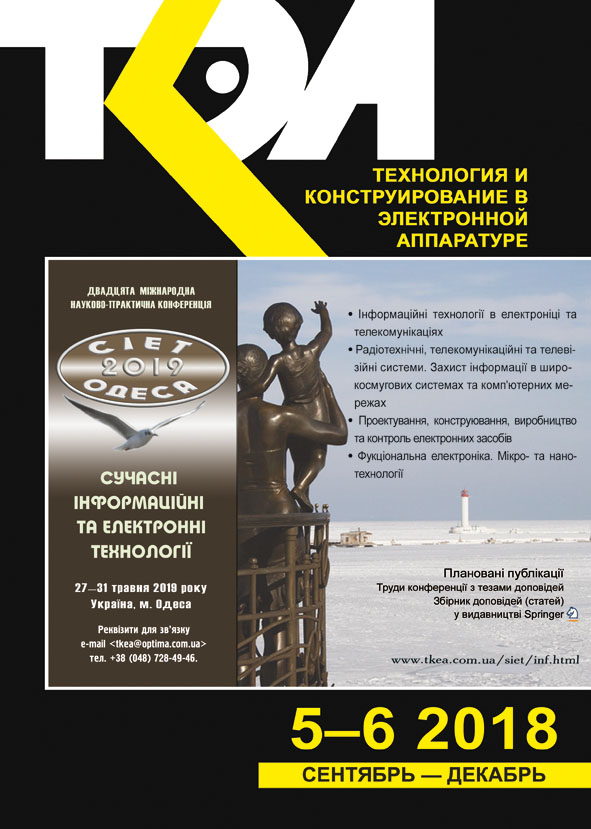Influence of temperature on optical properties of thin films Cu2ZnSnSe4
Abstract
The use of solar cells in various fields of science and technology contributes to the development of materials science and scientific activity in this area. Recently, scientists have been researching the optical and electrical properties of materials such as casterite. Casterite is a natural mineral which consists mainly of copper, zinc, tin, sulfur and selenium, that is, elements that are fairly widespread in nature. Therefore, solar cells, developed on the basis of casterite, will have, according to the researchers, a low cost. In addition, casterites belong to direct-gap semiconductors with a band gap of 0.9—1.5 eV and with a large optical absorption coefficient (≈ 104cm-1).In this work, the authors investigate the effect of temperature on the optical properties of Cu2ZnSnSe4 thin films of casterite obtained by the method of RF magnetron sputtering of previously synthesized material on glass substrates. Optical coefficients were determined by a method based on independent measurement of reflection and transmission coefficients. The reflection coefficient was studied at room temperature, and the transmittance — in the temperature range of 111—290 K. The measurements were made in the wavelength range from 0.9 to 26 μm. The obtained data were used to calculate the absorption coefficient and the band gap of the samples at different temperatures from the range under study. Studies have shown that direct interband optical transitions are observed in Cu2ZnSnSe4 films. The optical band gap at room temperature was 0.92 eV at a temperature coefficient of -1,29·10–4 eV/K, that is, the optical band gap decreases with temperature, which is typical of classical semiconductors.
References
Maistruk E. V., Koziarskyi I. P., Koziarskyi D. P., Andrushchak G. O. Optical properties of thin films CZTSe produced by RF magnetron sputtering and thermal evaporation. IEEE 7th International Conference Nanomaterials: Application & Properties (NAP), 2017, vol. CFP17F65-ART, 01PCSI28. https://doi.org/10.1109/NAP.2017.8190163
Maistruk E. V., Koziarskyi I. P., Koziarskyi D. P. et al. Structure and optical properties of thin films CZTS obtained by the RF magnetron sputtering. Proc. SPIE 10612, Thirteenth International Conference on Correlation Optics, 2018, 1061215. https://doi.org/10.1117/12.2304801
Koziarskyi I. P., Maistruk E. V., Koziarskyi D. P., Maryanchuk P. D. Electric properties of thin films Cu2ZnSnSe4 and Cu2ZnSnSe2Te2 (S2) obtained by thermal vacuum deposition. Zhurnal nano- ta elektronnoyi fizyky. 2018, vol. 10, no. 1, pp. 01028. (Ukr) https://doi.org/10.21272/jnep.10(1).01028
Pawar S. M., Inamdar A. I., Pawar B. S. et al. Synthesis of Cu2ZnSnS4 (CZTS) absorber by rapid thermal processing (RTP) sulfurization of stacked metallic precursor films for solar cell applications. Materials Letters, 2014, vol. 118, pp. 76–79 https://doi.org/10.1016/j.matlet.2013.12.047
Adelifard M., Torkamani R. Spray deposited Cu2ZnSnS4 nanostructured absorber layer: a promising candidate for solar cell applications. Journal of Materials Science: Materials in Electronics, 2015, vol. 26, iss. 6, pp. 3700–3706. https://doi.org/10.1007/s10854-015-2888-4
Cui Y., Deng R., Wang G. et al. A general strategy for synthesis of quaternary semiconductor Cu2MSnS4 (M = Co2+, Fe2+, Ni2+, Mn2+) nanocrystals. J. Mater. Chem, 2012, vol. 22, pp. 23136–23140. https://doi.org/10.1039/C2JM33574C
Xin Hao, Katahara J. K., Braly I. L., Hillhouse H. W. 8% Efficient Cu2ZnSn(S,Se)4 solar cells from redox equilibrated simple precursors in DMSO. Adv. Energy Mater, 2014, vol. 4(11). https://doi.org/10.1002/aenm.201301823
Yu X., Ren A., Wang F. Synthesis and Characterization of CZTS Thin Films by Sol-Gel Method without Sulfurization. International Journal of Photoenergy, 2014, vol. 2014, àrticle ID 861249. https://doi.org/10.1155/2014/861249
Tanaka K., Fukui Y., Moritake N., Uchiki H. Chemical composition dependence of morphological and optical properties of Cu2ZnSnS4 thin fims deposited by sol-gel sulfurization and Cu2ZnSnS4 thin film solar cell effiiency. Sol. Energy Mater. Sol. Cells, 2011, vol. 95, iss. 3, pp. 838–842. https://doi.org/10.1016/j.solmat.2010.10.031
Cooper C. S., Arnou P., Wright L. D. An innovative approach for fabrication of Cu2ZnSnSe4 absorber layers using solutions of elemental metal powders. Thin Solid Films, 2017, vol. 633, pp. 151–155. https://doi.org/10.1016/j.tsf.2016.12.026
Ukhanov Yu. I. Opticheskiye svoystva poluprovodnikov [Optical properties of semiconductors]. Moscow, Nauka, 1978. (Rus)
Koziarskyi I. P., Marianchuk P. D., Maistruk E. V. Optical properties of (3HgSe)0.5(In2Se3)0.5 crystals doped with Mn or Fe. Ukr. J. Phys. Opt, 2011, vol. 12, pp.137–142. https://doi.org/10.3116/16091833/12/3/137/2011
Maistruk E. V., Mar’yanchuk P. D., Solovan M. N. et al. Optical properties of thin Cu2ZnSnS4, films produced by RF magnetron sputtering. Optics and Spectroscopy, 2017, vol. 123, no. 1, pp. 38–43. https://doi.org/10.1134/S0030400X17070153
Copyright (c) 2018 Maistruk E. V., Koziarskyi I. P., Koziarskyi D. P., Maryanchuk P. D.

This work is licensed under a Creative Commons Attribution 4.0 International License.

